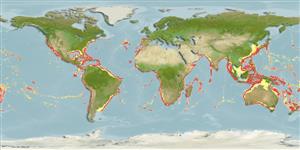Classification / Names
Common names from other countries
Main reference
Size / Weight / Age
Max length : 70.0 cm TL male/unsexed; (Ref. 30573); common length : 40.0 cm TL male/unsexed; (Ref. 30573); max. published weight: 4.0 kg (Ref. 43448); max. reported age: 23 years (Ref. 35874)
Length at first maturity
Lm 33.2 range ? - ? cm
Environment
Marine; benthopelagic; depth range 25 - 1300 m (Ref. 9833), usually 400 - 600 m (Ref. 27121)
Climate / Range
Subtropical, preferred 27°C (Ref. 107945); 45°N - 43°S, 180°W - 180°E
Distribution
Circumglobal, excluding the northeast Pacific and Mediterranean Sea (Ref. 9833). Western Atlantic: Gulf of Maine to the Gulf of Mexico (Ref. 6743). Eastern Atlantic: off southwestern Europe and the Canary Islands (Ref. 7413) to South Africa (Ref. 4179). Indo-Pacific: East Africa (including Saya de Malha Bank, Ref. 33390) to Japan, Hawaii, Australia, and New Zealand (Ref. 5755). The limited number of records in the western Pacific is doubtless the result of limited fishing effort below 200 m (Ref. 9833). Eastern Pacific: Chile (Ref. 27363).
Countries | FAO areas | Ecosystems | Occurrences | Introductions
Short description
Dorsal
spines
(total): 4;
Dorsal
soft rays
(total): 13-16;
Anal
spines: 4;
Anal
soft rays: 26 - 30. First infraorbital bone with a spine projecting laterally on anterior end. Lateral line extends to caudal fin. A fleshy disk on inner face of exposed area of scale. In young fishes, the 2nd dorsal ray is elongate (Ref. 559). Ref. 27363 notes pectoral fins with one spine and 17 soft rays (Ref. 27363).
IUCN Red List Status (Ref. 115185)
Threat to humans
Harmless
Human uses
Fisheries: commercial
Tools
Special reports
Download XML
Internet sources
Estimates of some properties based on models
Phylogenetic diversity index
PD50 = 0.6260 many relatives (e.g. carps) 0.5 - 2.0 few relatives (e.g. lungfishes)
Trophic Level
4.3 ±0.2 se; Based on diet studies.
Resilience
Low, minimum population doubling time 4.5 - 14 years (K=0.10-0.18; tm=5-7.5; tmax=23; Fec = 270,000)
Vulnerability
High vulnerability (57 of 100)
Price category
